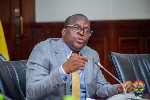Governance challenges in crisis management during Covid-19
 Prosper Bani
Prosper Bani
“Pandemics are one of the biggest threats facing humanity today. An infectious disease outbreak could rapidly lead to millions of deaths across the globe, destabilize governments, shut down trade and travel, and have significant, detrimental effects on the world’s economy.” (Harvard Global Health Institute, April 2017)
The world at various times and at different locations has experienced and responded to both natural and man-made disasters at the national, regional and global levels. These disasters were in the areas of conflicts, floods, droughts, energy, tsunamis, hunger, earthquakes, volcanoes, hurricanes, food and health. However, the novel coronavirus pandemic has exposed how vulnerable the global community is when it comes to responding to crisis of such unprecedented dimensions.
During earlier crises, the world had mobilized resources and deployed them to the specific areas to support the recovery efforts and to address the humanitarian impact. The United Nations, the World Bank, International Development and Humanitarian Agencies, and national development and humanitarian agencies supported such efforts through technical and financial resources to the countries and regions that were affected. The current monumental disaster which has affected both the developed and the developing countries, has thrown a challenge and exposed the existing development and humanitarian assistance paradigm, which is based on a vertical and dependency relationship between the developed and the developing world.
Indeed, in the 1990s and beyond all development agencies in Europe and America established crisis response units or crisis departments within their specific organizations to enable them put in place the best practices on crisis response and recovery governance. These departments became very attractive as regional and intra-country conflicts, and natural disasters were rising in mostly Asia and Africa, and there was very little capacity and methodology available to respond to the increasing disasters. The new initiatives to increase capacity and to deepen thinking in the area attracted a lot of resources and best talents who were prepared to be deployed to respond to dangerous global emergencies. A lot of investments were made into research, expertise recruitment and deployment in the wake of disasters across nations. Agencies were in competition for resources as well as becoming the thought leaders in the field. Universities were not left out as most of them were funded to conduct research into conflict management and disaster risk reduction.
The floods and drought emergencies in Africa, the hurricanes in South America, the tsunamis in Asia and the numerous conflicts in South Eastern Europe, Africa and parts of the former Soviet Republics are a few emergencies that have confronted the world since the 1990s. This period witnessed a huge chunk of development assistance being diverted into crisis response and humanitarian assistance. The outcome of these responses culminated in building a huge knowledge base and thought processes on crisis prevention and recovery and also mainstreaming crisis prevention into development plans in places known to be prone to crises. The decision 30 years ago to invest into establishing crisis management governance practice was seen as a way to enable countries to be prepared, build capacities and effective institutions and become more efficient in responding to emergencies.
Nevertheless, SARS, Ebola, Zika and now the novel coronavirus have demonstrated how unpredictable and devastating such pandemics can be to global economies and the effect such disasters have had and are having on the livelihoods of everyone.
As we confront the crisis of the novel coronavirus pandemic, we are also confronted with the challenges of crisis management governance across the globe. The sudden spread of the virus from its original epicenter in China to other Asian countries, Europe, Middle East, the United States and Africa took the world by surprise and the response at the beginning has consisted of knee jerk reaction, which in turn has exposed the world for its lack of preparedness for a disaster like the coronavirus pandemic.
Indeed, global leadership has failed us from one crisis to another as political leaders refuse to learn from lessons of previous pandemics, and abandoned the investments in global regional and national preventive and response measures. President Obama, after the Ebola crisis clearly stated that we “should put in place an infrastructure ……that allows as to see it quickly, isolate it quickly and respond to it quickly” so that we can have our hands on any virus such as the coronavirus early enough before it becomes a pandemic. The emphasis here is on prevention rather than recovery.
It is therefore imperative that all countries should begin to reengineer and rethink their development investment priorities and provide adequately for disaster prevention including the prevention of pandemics. The number of people dying daily across the globe as the result of the COVID-19 is sobering, and the search for a vaccine seems to be between one or two years away. If we are lucky it would come earlier than expected. We have failed as a community because we did not take the opportunity of previous pandemics to invest in prevention infrastructure to reduce the impact on the coronavirus pandemic.
The first global conference on disaster risk reduction to raise awareness and to agree on a plan of action was the Yokohama conference: The “Yokohama Strategy and Plan of Action for a Safer World: guidelines for natural disaster prevention, preparedness and mitigation” which was adopted in 1994 and was aimed at guiding action for reducing disaster risks and the impact of disasters. This was followed by another global initiative the “Hyogo Framework for Action 2005-2015” which focused on how to effectively “integrate disaster risk considerations into sustainable development policies, planning and programming at all levels with a special emphasis on disaster prevention, mitigation, preparedness and vulnerability reduction”. The Sendal framework for Disaster Risk Reduction 2015-2030 which was the third global initiative following the elaborate frameworks of Yokohama and Hyogo and advocated for “the substantial reduction of disaster risks and losses in lives, livelihoods and health and in the economic, physical, social, cultural and environmental assets of persons, businesses, communities and countries”.
The United Nations also established the Office of the United Nations Disaster Risk Reduction in 1999 to promote and encourage the implementation of the International Strategy for Disaster Risk Reduction. The United Nations Strategy was adopted in 2000 to guide in the coordination of efforts with parties to reduce the potential for and enhance resistance to disasters. These protocols and guidelines were reinforced by the Hyoko framework for Action 2005 – 2015.
While global progress has in the last two decades been confronted by disasters of various degrees and at different locations, it is now undeniably clear that if we as a people do nothing about building resilience to natural and manmade disasters, our collective efforts at human development would be eroded.
In Africa, development is being challenged by the lack of a strategy to link disaster risk reduction to development initiatives. The Africa Regional Strategy for Disaster Risk Reduction (July 2004,) emphasized the importance of policy makers to look at strengthening “institutional frameworks, risk identification, knowledge management, governance and emergency response” and demanded political commitment to addressing comprehensive policies on disaster risk reduction as part of development plans. Inspired by the Global and Regional protocols, the Economic Community of West Africa States responded by developing a regional policy (August 2006), focused on developing a network of national platforms, expanding early warning systems and encouraging coordination and harmonization, support public awareness and also advocating the mainstreaming of disaster risk reduction into national frameworks.
The absence of preventive infrastructure has caused significant reverses in the development effort of most African countries as manifested in prolonged droughts in the Horn of Africa, devastating floods, uncontrolled bushfires, landslides, tropical cyclones, volcanic eruptions, and the health epidemics as well as pandemics such as Ebola and the coronavirus that have affected and continue to derail development initiatives.
There is evidence that the world and Africa in particular have been inundated with Protocols, Action Plans, Guidelines, and numerous international agreements on disaster risk reduction, and in particular how to reduce the risk and impact of disasters. In fact, the latest has been the development of an Action Plan for Africa following the Sendel Framework of 2015 which was finalized in 2016. One would ask whether any member state has invested in the implementation of the Action plan which could have mitigated the impact on the economies of member states during the coronavirus. One would have to diligently search for budgetary allocations to National Disaster Organizations, and from country to country you will find very minimal or no allocations for Disaster Prevention. Yet, global institutions and national actors are quick to respond to alarming budget proposals presented after a disaster based on incomplete response plans if you find any. The inaction of member states and partners to prioritize prevention and preparedness over the years has made the continent very vulnerable to major disasters. This indifference has resulted in the scattered and uncoordinated manner some countries are responding.
We should have well developed plans and strategies to respond to the novel coronavirus pandemic. The plans must articulate clearly what the problems are and how they would be addressed. It should reflect a verifiable budget and expenditure plan, awareness raising to bring along the citizens to become conscious and aware of their responsibilities in the fight to reduce the spread, frontline health workers must be motivated and provided with the necessary personal protective equipment, and enhance the capabilities of health institutions, efficient campaign on the adherence to the World Health Organization’s preventive protocols, ensure that response plans are dovetailed into an effective humanitarian response strategy, establish a crisis management response command structure with a monitoring and feedback system, and a system to collect and manage science based data and facts for decision making. Crisis Managers must institute a well-organized, resourced and managed process of testing, isolation and quarantine, as well as treatment to contribute to reducing the spread of the coronavirus and save lives.
Member states of the United Nations and the Africa Union should learn from their past failures in responding to disasters, and while recovering from the current pandemic begin to build back better. Conflicts and natural disasters provide opportunities to development actors to rethink their development trajectories and mainstream disaster preparedness and response into development/recovery plans. Countries must also invest in prevention mechanisms and strengthen the capacities of National Institutions to prepare and respond to disasters to reduce the loss of life, properties and livelihoods. Hopefully, by the time of the next disaster, we as a people would be better prepared and respond more efficiently.
Source: Prosper Bani, chairman of the NDC COVID-19 Technical team and Former Chief of Staff to President Joh
Trending News

I will form a truly representative government -Alan kyerematen
18:03
EC interdicts five officials over missing BVDs
13:33
Government’s performance tracker will promote transparency and accountability – Kennedy Osei Nyarko
08:46
7 groups combine forces with Alan's MFC to form ARC
14:45
Int'l Medical Lab Science Day: Amend relevant laws to improve the regulation of our profession – GAMLS to gov’t
13:37
Fire sweeps through Madina market
03:59
Expand the policy space beyond the executive arm of gov't - Bagbin to Dev't partners
14:23
Ukraine opens resident mission in Accra
11:23
GACL interdicts KIA staffers who helped Dutchwoman smuggle cocaine
03:39
Let's diversify VRA, ECG – Otumfuo tells gov't
14:10



